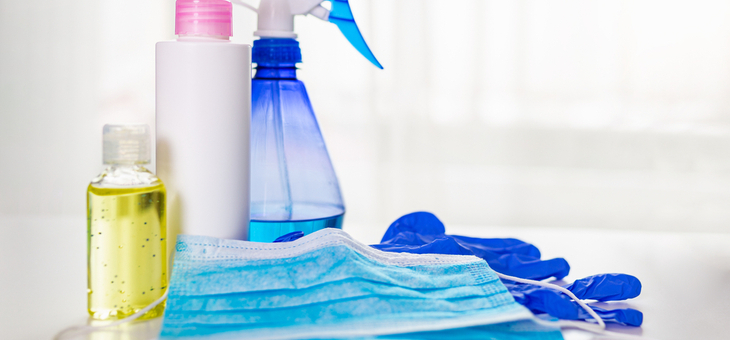Hygienic citizens are facing a new challenge during the pandemic, with increased use of cleaning products triggering asthma attacks.
Asthma Australia reports that 29 per cent of recent survey respondents said their asthma was activated by an increased use of cleaning products in their homes during the coronavirus pandemic.
Cleaners and disinfectants end up in the air we breathe and on the things we touch, says Asthma Australia. Once there, they can irritate the airways and skin. Asthmatics must be aware of what is being used and where, the organisation says.
“The first thing is for people to be aware that there are more cleaning chemicals being used around us during this time of coronavirus and there’s not much we can do about that,” says Asthma Australia CEO Michele Goldman.
“As we get out and about more, it does present as a real barrier to people with asthma. But there are some things you can do to prepare and reduce your exposure.”
Ms Goldman says some of the biggest culprits for triggering asthma are disinfectants such as bleach and ammonia, which when mixed are particularly harmful.
“Artificial fragrances found in household products are another trigger.”
People with asthma are at higher risk of getting very sick from COVID-19, according to the US Centers For Disease Control.
“COVID-19 can affect your nose, throat, lungs (respiratory tract); cause an asthma attack; and possibly lead to pneumonia and acute respiratory disease,” it says.
Respiratory health risks will become more important as disinfectants are used more, says Orianne Dumas, a researcher at the French National Institute of Health and Medical Research.
She told chemicalwatch.com: “It is likely that the COVID-19 pandemic will impact both individual behaviours and disinfection practices in healthcare settings. Currently, adequate levels of disinfection must be maintained in healthcare settings to protect patients and workers from infections, including COVID-19.
“In the years to come, if cleaning and disinfection recommendations are to change, they should integrate knowledge on respiratory health risks associated with (the) risk of disinfectants and cleaning products. In healthcare settings, this may require the development of new strategies for infection control.”
Addressing the return of children with asthma to school, The Lancet says “various household cleaning products have been associated with an increased risk of asthma and wheeze across all age groups”.
“Consequently, cleaning products used in schools should be free of organic compounds, irritants or fragrances.”
Asthma Australia advises asthmatics to:
· Understand your triggers and reduce your exposure in circles of your control such as in your home and frequently visited homes of family or friends.
· Always have an asthma reliever puffer and spacer on hand in case of emergencies.
· Take your preventer medication as prescribed, and if you’re experiencing new or increased symptoms, follow your Asthma Action Plan and consult your GP for an asthma review.
· Ring ahead to reduce your risk – if you have an appointment such as for a hairdresser, phone ahead and check what cleaning routines consist of, and how they can cater for you before your appointment.
· For children at schools, be sure to speak to the classroom teacher about what cleaning routines consist of and how this could be adjusted to safely accommodate your child.
· Notify your employer and have an empowered discussion about ways to stay well at work and what options are available to you.
Employers are encouraged to check if anyone on their staff is sensitive to health affects from cleaning chemicals, and to consider ways to reduce their risk, such as switching from sprays to wipes, and choosing allergy friendly products where appropriate.
The federal Department of Health recommends cleaning frequently touched surfaces such as door handles, bedrails, tabletops and light switches with a detergent solution during COVID-19.
Safe use of disinfectants:
· Always follow the label – this applies to everyone. Use only the recommended amounts and follow procedures for use.
· Use products that could reduce your inhalation exposure, such as wipes or dampened towels, to disinfect surfaces. These options will substantially lower inhalation exposure compared to sprays, which generate aerosols.
· Wash your hands with soap and water for at least 20 seconds immediately after cleaning. Throw away protective wear if damaged or soiled with bodily fluids.
· Protect yourself by wearing waterproof cleaning gloves and masks if available. Chemicals and fragrances in cleaning products can irritate skin, eyes and lungs, so avoid direct contact and use the least toxic product whenever possible.
· Ventilate well during and after cleaning (e.g. opening windows) no matter what the product.
· Protect others in your household by cleaning when others aren’t around or moving household members to a different room while you clean.
· Store cleaning materials out of reach of children and pets.
· Never mix products! (e.g. chlorine or bleach plus ammonia can produce deadly gases.)
Sources: Massachusetts Asthma Action Partnership; epa.gov
Do you know what’s in your cleaning products? Have you had breathing difficulties as a result of any cleaning products you’ve been using?
If you enjoy our content, don’t keep it to yourself. Share our free eNews with your friends and encourage them to sign up.
Related articles:
https://www.yourlifechoices.com.au/health/news/hospital-cleaners-share-top-tips
https://www.yourlifechoices.com.au/kitchen-cleaning-mistakes
https://www.yourlifechoices.com.au/travel/news/new-cleaning-standard-for-hotels

